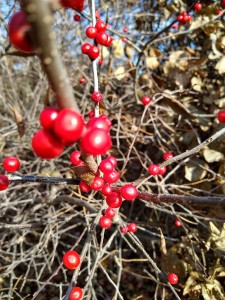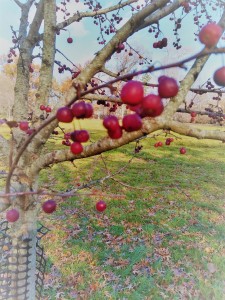Winter can be beautiful, with bright clear mornings when the sun glints off fresh snow and the world looks pristine. Winter can also be ugly, with a succession of gray days interrupted only by the promise of mass transit delays and more snow shoveling. Either way, it helps—if only just a little—to have some color in the garden. Shrubs and trees with berries that persist through the winter do that job nicely. They also act as food plants for overwintering birds, which means that some of that desirable life and color will arrive in the garden on the wings of bright red male cardinals or chatty jays clad in vivid blue.

If you are lucky enough to have holly—Ilex—in your garden, you already appreciate its contribution to the winter landscape. The bright red berries are a hit at holiday time and an inspiration through the dark days thereafter. Holly has only a few downsides, one of which is the fact that only female trees can bear fruit and those females need a nearby male holly plant to enable that operation. If your holly does not bloom, either it is a lonely female, a lonely male, or it has been pruned at the wrong time, eliminating the flowers that eventually give way to the berries.
One of my favorite hollies is winterberry holly, Ilex verticillata. Unlike many of its relatives, winterberry is deciduous and loses its leaves when cold weather sets in. The denuded stalks are a stark contrast with the abundant scarlet fruits. Many flower arrangers consider the winterberries even more beautiful than their evergreen relatives.
Rose family members often have beautiful fruits. Some shrivel when frost comes, but others persist through the winter. The red chokeberry or Aronia arbutifolia is a multi-stemmed shrub that tops out at about eight feet tall. Native to eastern North America, chokeberry has a decorative nature that makes it easy to like. In the spring the shrub sports clusters of small pinkish-white flowers. Each one has five petals and if you look closely, you will see the floral resemblance to wild roses. In late spring and summer, finely-toothed, ovoid leaves carry the burden of beautifying the chokeberry. These turn a glorious red shade in the fall, before dropping to reveal the berries in all their glory. Loved by birds and wildlife, the aronia fruits are small and extremely sour, hence the “choke” part of the common name. If you are a wild food enthusiast, however, you can collect them, add a sweetening agent and turn them into jams or baked goods. I prefer to leave the berries on the shrub to do decorative duty through the winter.
Crabapple or malus varieties are also members of the rose family. Most people buy them for the glorious spring flower show, but four-season gardeners know that most commercially available varieties also set colorful, long-lasting fruit. If you have enough space, install two flowering crabs, one that bears red “apples”, and another, like ‘Autumn Treasure’ or ‘Brandywine’ that produces yellow or gold autumn fruit. In winter the little crab apples hang like jewels on the trees.
If you have ever pruned a Pyracantha coccinea, or scarlet firethorn shrub, without gauntlets, you have felt the pain that comes with this highly decorative plant. Firethorn is another member of the rose family and is generally well-armed with long spines, making it great for boundary hedges, privacy barriers and other situations where excluding humans or animals is necessary. More sociable individuals can train the rambunctious, fast-growing stems up arches, tall trellises or sturdy walls.
Pyracantha is a little like a brilliant fractious teenager. Gentle but persistent supervision and discipline is the best way to achieve a good outcome. Pruning is a must if you don’t want your firethorn to end up as a 30 by 25 foot raging inferno. To give yourself the best chance at a reasonable-size plant and plenty of berries, prune after flowering in the spring. Cut back thick, older canes to the ground and shape as necessary. If you prune judiciously, the shrub will reward you with flat-topped clusters or corymbs of white spring flowers, followed by red-orange berries that mature in the fall and persist well into the winter. In slightly warmer climates, pyracantha may be evergreen or semi-evergreen. A well-tended pyracantha with exuberant berries is a lovely sight in November and December.
Winter is the time to seek comfort where you can find it. Inside that means warm sweaters, a comfy chair near a heating unit, and pot roast in the oven. Outside, it means warming the landscape with the flames of bright berries.

